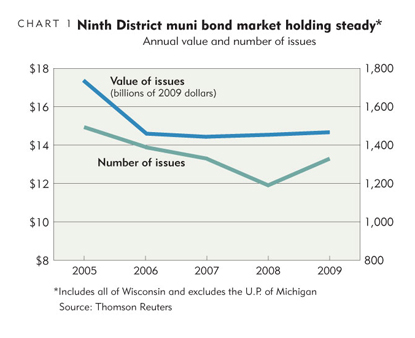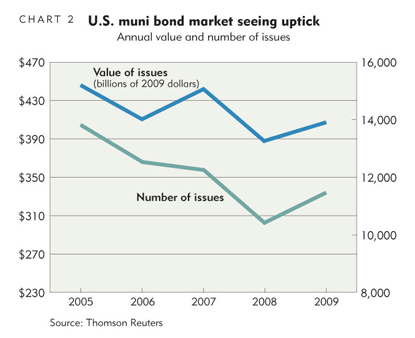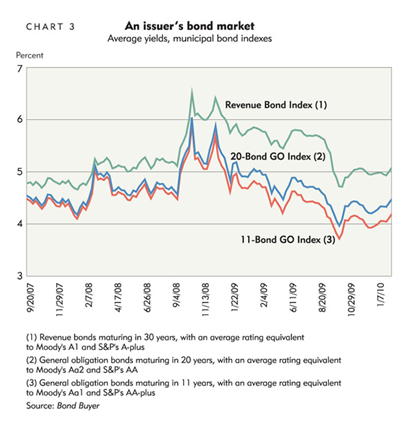Imagine you’re a business owner hoping to borrow money despite the fact that your firm—though well-established and generally stable—is currently having problems trying to make ends meet, and that’s not likely to change much in the short-term.
You brace for the lender’s response and hear: “No problem—and how about we borrow you money at cheap rates, too?”
In today’s skittish financial markets, this might seem like fantasy. But not so with municipal bonds, which are getting a generally warm reception from investors when state and local governments seek to borrow money for a new bridge, low-income housing or a variety of other public uses.
The reasons for this amenable credit environment generally have to do with the secure nature of municipal bonds, the lack of good, comparable alternatives and, more recently, a federal bond program that encourages municipal issuers to sell bonds and offers incentives for investors to buy them. Data on current bond issuance also omit a significant amount of additional local and state financing being propped up by other federal initiatives. While these federal supports might be viewed as a boon for municipal issuers that need to raise money, they also distort bond markets and impose significant costs on taxpayers.
Large bills, please
When local and state governments (including their related authorities) need to borrow money for capital projects and a host of other priorities, they sell municipal bonds—the umbrella term for these debt securities.
Last year, the value of municipal bonds issued in the Ninth District rose by just 1 percent; since 2006, annual values (inflation-adjusted) have been table-top flat. Gains were higher last year at the national level, though annual levels over the past few years have been more volatile compared with the Ninth District. (See Charts 1 and 2. All issuance data come from Thomson Reuters, a business data and services firm.)
This might seem like a tepid performance, until you compare it with credit conditions in the broader economy, which are at a virtual standstill: Businesses and consumers are nervous about borrowing and investing, and lenders have raised the bar on who can receive credit.
Total outstanding loans and leases among U.S. commercial banks dropped by about 7 percent—or more than $500 billion—last year, according to Federal Reserve data. Corporate bond issuance last year bounced back after a steep drop in 2008, but is still 25 percent below inflation-adjusted levels from 2007, according to figures from the Securities Industry and Financial Markets Association (SIFMA). Mortgage-related bond issuance recovered somewhat last year after a great deal of support from the federal bailout of Fannie Mae and Freddie Mac and an aggressive program by the Federal Reserve to purchase mortgage-backed securities. And finally, asset-backed bond sales in 2009 are off almost 80 percent from 2006.
Although it’s not quite as obvious in the overall data, the municipal bond market also saw considerable volatility that began in 2007 and came to a head near the end of 2008. (Read more about this volatility in the November 2008 issue of the fedgazette.) But by many measures, the market is currently on stable ground, evident in the fact that the total number of bond issues reversed course last year and ticked upward, both in the district and nationwide (See Charts 1 and 2).
Strong demand for municipal bonds pushed rates downward after a rate spike in late 2008, when financial markets seized up worldwide (see Chart 3). David MacGillivray, a principal at Springsted Inc., a Twin Cities-based municipal bond consultancy, said via e-mail that investors were looking for a safe haven after the financial crisis. After flocking to treasuries, according to MacGillivray, investors “began to realize that higher yields at basically the same risk level could be obtained in munis. This drove up the demand for munis” and forced yields—the returns investors are willing to accept to part with their money—down.
Lower rates have reportedly also generated increased bond refinancing. (Refinancing activity is not reflected in Charts 1 and 2, which tally only primary, or new, issues.) Last fall, for example, the city of Grand Forks, N.D., refinanced three separate bond issues for various water infrastructure projects, saving the city an estimated $1.7 million. Bond refinancing in Minneapolis will reportedly save upward of $8 million.
Look closer: More ups and downs
The apparent stability of the municipal bond market nonetheless covers up some volatility in recent years among district states and the various levels of local and state government that issue muni bonds. Wisconsin, for example, has seen the value of bond issuance increase significantly since 2007, growing from $5.1 billion to $6.6 billion in 2009, much of it due to a $1.5 billion bond issue sold to cover a state deficit. Total bond issuance in Montana has gone the other direction, free-falling from almost $1.4 billion in 2006 to $153 million last year.
It’s more instructive, however, to look at particular bond categories, or so-called use of proceeds. Some uses for bond proceeds are seeing an upward trend. For example, bonds sold for general use and public improvements have skyrocketed (see Chart 4). Proceeds from these bonds can go toward a wide range of uses, and the net increase is almost entirely from Wisconsin and Minnesota. Montana and the Dakotas sell comparatively few bonds for general uses, though sales are rising there as well. (For additional data and charts on municipal bond trends at the state and issuer level, view the spreadsheet [xls].)
For other programs or uses, bonding issuance is dropping. For example, bond sales to private investors to fund housing programs in district states have witnessed a steady decline (see Chart 4), most likely the result of investor fears over a slumping housing market. And every district state, save Wisconsin, has seen bond proceeds for health care facilities drop significantly in the past year or two.
MacGillivray, from Springsted, said that financial standing has a strong bearing on how individual municipal issuers fare in the bond market. Bonds from highly rated municipal issuers, he said, “continue to have a good market reception with relatively lower interest rates,” while lower-rated issues run into more difficulty and are sold at higher interest rates. Such a pattern can also be seen in the wider spread between general obligation and revenue bonds (see Chart 3).
Revenue bonds tend to be lower rated because they depend on project income to repay bond debt. As a result, they are inherently more risky than general obligation bonds that are backed by the full faith and taxing powers of an issuing government. MacGillivray added that noninvestment grade issues, like those used to fund local economic development projects, typically get no takers until projects have established a revenue history. This can mean some projects never get off the drawing board.
Lending a hand—or a shove
But bond issuance data don’t tell the whole story, because the federal government has intervened to provide financing to local and state governments in areas where the private bond market has backed away. Much of this federal assistance is not captured in the Thomson Reuters data, which track only private-buyer bond purchases.
For example, the Montana Higher Education Student Assistance Corp. is authorized by the state to sell bonds to finance student loans. The collapse of the auction-rate bond market in 2008 dried up hundreds of millions of dollars in traditional funding for the organization. (More on this topic can be found in the November 2008 fedgazette.)
Enter federal lawmakers, who in 2008 created a program whereby MHESAC can sell student loans from previous academic years to the federal government, with the proceeds funding new student loans. The arrangement is similar to the home-mortgage liquidity provided by Fannie Mae and Freddie Mac.
An even more prevalent example in the district involves local and state housing authorities, which typically issue bonds to pay for various home-finance programs, including those serving first-time and low-income buyers. As Chart 4 demonstrates, private investors have shied away from buying these program bonds because of the shakiness of the overall housing market.
Despite these clear market signals—or because of them, depending on your perspective—the federal government started two programs last fall to fund these housing organizations. The New Issue Bonds Program involves swapping municipal bonds for more desirable securities from Fannie Mae or Freddie Mac. Once the swap has taken place, the U.S. Treasury buys the securities from the municipal issuer. Last year, housing agencies in 49 states took advantage of this three-way swap, including state housing agencies in each district state and two local agencies in Minnesota—the Dakota County Community Development Agency and the Minneapolis-St. Paul Housing Finance Board. In total, seven housing agencies have been authorized to receive up to $1.2 billion in financing through this program, according to a federal database.
Yet another program provides temporary credit and liquidity to these same housing authorities using similar financial arrangements with the U.S. Treasury and Freddie Mac and Fannie Mae. Only one agency in the district—the Wisconsin Housing and Economic Development Agency—had received an allocation from the program as of January, but to the tune of almost $500 million, according to federal data, allowing the agency to restart a first-time home buyer program in March that had been mothballed for 17 months.
None of this replacement financing shows up in annual municipal bond statistics; if it were added, the total value of local and state borrowing would have been considerably higher.
Bond tower of BABble
The entire municipal bond market also got an across-the-board boost from last year’s federal stimulus bill, which created the Build America Bonds (BAB) program.
Most muni bonds are tax exempt, but BABs are taxable bonds issued for local and state infrastructure projects. Because they’re taxable, BABs have to offer higher yields to attract buyers. The hook here is that the federal government pays the municipal issuer 35 percent of interest costs—effectively subsidizing both the issuer and the investor by lowering net issuer costs while matching and possibly beating net yields that investors can earn from tax-exempt or corporate bonds.
Given the subsidies, it follows that BABs have proven popular. The first Build America Bonds were issued last April, and they accounted for about 16 percent of the $410 billion in municipal bonds issued in 2009. (Because they are purchased by private investors, BABs are counted in the Thomson Reuters annual data.) But that market share has increased over time. In the fourth quarter of last year, BABs made up almost one-third of all municipal bond issues.
Use of BABs in the district is both high and low, depending on how you measure. Minnesota and Wisconsin have been frequent issuers of BABs, ranking second and third (respectively, behind California) in the number of BABs issued nationwide in 2009, according to a January SIFMA report. However, BAB deals in both states are comparatively small in size; at $443 million in Minnesota and $781 million in Wisconsin, neither state cracked the top 20 in terms of the total value of BABs issued. South Dakota has issued $141 million in BABs, North Dakota just $22 million, and Montana has yet to issue its first BAB.
The expectation is for the BAB program to continue growing. A Congres- sional Budget Office report released in January noted that BAB participation “has already risen to a level significantly higher than CBO’s ... original estimates.”
Some industry sources predict that Build America Bonds could reach $100 billion to $150 billion this year—or close to 30 percent of all municipal bonds. The BAB program is also keeping a lid on rates for traditional tax-exempt municipal bonds because it is providing an attractively priced alternative for both buyers and sellers of municipal bonds. Matt Fabian, managing director of Municipal Market Advisers (MMA), a bond market research firm, said, “I think it’s pretty clear that [BABs] have been replacing, on almost a dollar-for-dollar basis, funds that would have been sold tax exempt. So they are contributing to a scarcity situation” for tax-exempt bonds. If that’s the case, the BAB program hasn’t necessarily expanded the municipal bond market as funds flow from one muni bond type to another.
Clouds or sunshine?
How long these conditions and circumstances last in the muni bond market is an open question, in part because some countervailing forces are at work.
For example, though defaults in this bond sector are still rare, particularly compared with corporate bonds, they are nonetheless increasing. In 2007, less than $1 billion in municipal bonds defaulted. In late January, Fabian of MMA estimated that $16 billion worth of municipal bonds was in some form of payment distress, including $5 billion “where investors actually missed getting paid.”
But pushing in the opposite direction is the BAB program. Although the program is slated to run only through the rest of this year, in late January, President Obama proposed making it permanent, with a small reduction in the subsidy to 28 percent starting in 2011. That’s a positive development for issuers and investors alike but an extra burden on taxpayers, who pay the program’s annual subsidy of $2 billion to $3 billion, an amount that will grow as more BABs are issued. Total costs, however, are somewhat offset by federal taxes on income earned from these taxable bonds. In budget documents, the Obama administration has estimated total net BAB subsidies of $5.6 billion through 2015.
At the same time, inflation fears are growing and the financial condition of state and local governments is in tatters. Estimates for the upcoming fiscal year predict that states face cumulative budget deficits of between $150 billion and $180 billion, some of which likely will be papered over by bonds from issuers whose creditworthiness has clearly deteriorated. All of these factors put upward pressure on the rates municipal issuers will have to pay to find buyers.
Ron Wirtz is a Minneapolis Fed regional outreach director. Ron tracks current business conditions, with a focus on employment and wages, construction, real estate, consumer spending, and tourism. In this role, he networks with businesses in the Bank’s six-state region and gives frequent speeches on economic conditions. Follow him on Twitter @RonWirtz.








